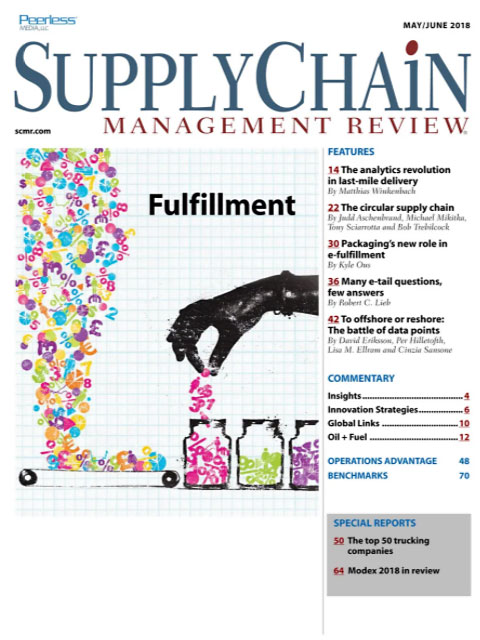Sorry, but your login has failed. Please recheck your login information and resubmit. If your subscription has expired, renew here.
May-June 2018
Last month, I was in Atlanta at the Modex trade show. In one sense, it is a tribute to the automation technologies managing today’s distribution networks. And, I’m not only talking about automated materials handling systems, but also the software and NextGen technologies such as robotics, wearable technologies, including smart glasses and augmented reality solutions and sensors enabling the Internet of Things. In another sense, all of these solutions are coming together to drive fulfillment. With the increase in e-commerce, getting the right product to the right customer at the right time has never been more important. Browse this issue archive.Need Help? Contact customer service 847-559-7581 More options
If you purchased the new release of a Stephen King novel from Amazon back in the late 90s, in all likelihood you paid for shipping and waited a week or more for the book to arrive on your porch in an over-sized box filled with air pillows. As you read the pages of King’s latest thriller, you probably didn’t stop to think that you might have been at the front end of a fundamental disruption in the way consumers shop, retailers sell to their customers and supply chain operations fill an order. You just wanted the convenience of having a book delivered to your door.
Now, let’s fast forward 20 years and think about the way things have changed. Order that same book today, and you probably expect it to arrive on your doorstep in two days or less—and if you live in an urban area, perhaps in a matter of hours. In many cases, the delivery is free. And, in the best-case scenario—and we want to emphasize best case—the packaging has been optimized for the book, minimizing the amount of waste you, the customer, send to the landfill.
The logistics associated with that 21st century e-fulfillment supply chain are astounding; what’s more, the pressure for organizations to keep up with a whirlwind of changes and customer expectations is greater than ever. And, it’s only going to get worse. While e-commerce makes up just 10% of global retail purchases, sales are steadily rising and organizations across the globe are scrambling to fulfill orders in geographical regions they previously haven’t served. As a result, retailers are forced to carefully manage their customers’ buying experiences in the fight to earn their loyalty. That is resulting in faster click-to-ship order processing times, constant communication with the customer and speedier delivery. Additionally, the omni-channel supply chain has transformed last mile strategies and added new levels of complexity when serving customers.

This complete article is available to subscribers only.
Log in now for full access or start your PLUS+ subscription for instant access.
SC
MR
Sorry, but your login has failed. Please recheck your login information and resubmit. If your subscription has expired, renew here.
May-June 2018
Last month, I was in Atlanta at the Modex trade show. In one sense, it is a tribute to the automation technologies managing today’s distribution networks. And, I’m not only talking about automated materials… Browse this issue archive. Access your online digital edition. Download a PDF file of the May-June 2018 issue.If you purchased the new release of a Stephen King novel from Amazon back in the late 90s, in all likelihood you paid for shipping and waited a week or more for the book to arrive on your porch in an over-sized box filled with air pillows. As you read the pages of King's latest thriller, you probably didn't stop to think that you might have been at the front end of a fundamental disruption in the way consumers shop, retailers sell to their customers and supply chain operations fill an order. You just wanted the convenience of having a book delivered to your door.
Now, let's fast forward 20 years and think about the way things have changed. Order that same book today, and you probably expect it to arrive on your doorstep in two days or less—and if you live in an urban area, perhaps in a matter of hours. In many cases, the delivery is free. And, in the best-case scenario—and we want to emphasize best case—the packaging has been optimized for the book, minimizing the amount of waste you, the customer, send to the landfill.
The logistics associated with that 21st century e-fulfillment supply chain are astounding; what's more, the pressure for organizations to keep up with a whirlwind of changes and customer expectations is greater than ever. And, it's only going to get worse. While e-commerce makes up just 10% of global retail purchases, sales are steadily rising and organizations across the globe are scrambling to fulfill orders in geographical regions they previously haven't served. As a result, retailers are forced to carefully manage their customers' buying experiences in the fight to earn their loyalty. That is resulting in faster click-to-ship order processing times, constant communication with the customer and speedier delivery. Additionally, the omni-channel supply chain has transformed last mile strategies and added new levels of complexity when serving customers.
SC
MR


Latest Supply Chain News
- Survey reveals strategies for addressing supply chain, logistics labor shortages
- Israel, Ukraine aid package to increase pressure on aerospace and defense supply chains
- How CPG brands can deliver on supplier diversity promises
- How S&OP provides the answer to in-demand products
- AI, virtual reality is bringing experiential learning into the modern age
- More News
Latest Podcast

 Explore
Explore
Procurement & Sourcing News
- Israel, Ukraine aid package to increase pressure on aerospace and defense supply chains
- How CPG brands can deliver on supplier diversity promises
- How S&OP provides the answer to in-demand products
- There is still work to do to achieve supply chain stability
- Blooming success: The vital role of S&OE in nurturing global supply chains
- How one small part held up shipments of thousands of autos
- More Procurement & Sourcing
Latest Procurement & Sourcing Resources

Subscribe

Supply Chain Management Review delivers the best industry content.

Editors’ Picks






